Level of surfing
Advanced
Quality of surf
Excellent
Call code
679
Net code
fj
Area
18274
Coastline
1,129 km
Climate
Tropical Maritime
Hazards
Coup / Civil Unrest
Best Months
May - September
Population
853445
Currency
Fijian dollar (FJD) Fijian dollars per US dollar - 1.7313 (2006)
Time Zone
New Zealand Standard Time (NZST) MIKE (UTC+12)
Special Requirements
Private Beaches, Special Pass / Permits
introduction
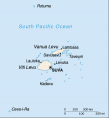
Map of Fiji
Fiji is nestled in the South Pacific to the north of the great swell corridor that feeds Australia and New Zealand directly from the Antarctic. The country itself is an archipelago of 322 islands and over 500 islets. Only about 100 of these are permanently populated. Only the barest tip of the Fijian surfing iceberg has been explored.
Whilst the likes of Cloudbreak, Frigates Passage and the exclusiveness of Namotu are well known and photographed, it will be the as yet undiscovered or publicised gems of the outer islands and reefs that will ensure this country continues to grow as a surfing destination of choice.
history
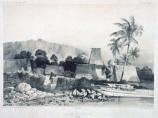
NOAA: Village de Lebouka. Iles Viti. by the French ships ASTROLABE and ZELEE; 1842
The area known as Fiji was settled by Polynesian peoples around 1500BC. Subsequent pacific immigration waves by the Melanesian peoples and the subsequent intermarriages led to the unique physical and cultural appearances of modern Fijians. Europeans first commenced visiting the islands in the 1600’s but it was not until 1874 that the group actually came under the control of Britain as a colony.
British rule was to see a large number of Indian migrant labourers imported to assist in the construction of the colony. This was eventually to lead to a political destabilisation of the country as native Melanesians protested over the more affluent Indo-Fijian community. The country experienced two military coups in 1987 and a further coup in 2000.
Despite real violence that prevailed during these periods, unrest was almost entirely restricted to the capital, Suva and resulted in no foreign casualties. Claims of corruption and ongoing political instability have prevailed, though the fact that the recent uprisings have been postponed to prevent conflict with the nations Rugby Union commitments suggest that whilst Fijian politics remain turbulent, they pose no major threat to the average visitor. Still – it would be wise to avoid any groups or congregations of people especially in the main cities of Nadi and Suva. To be honest, I would be avoiding Suva all together if you have any concerns.
surfing
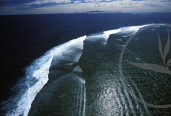
Tim McKenna: Cloudbreak, Fiji (www.tim-mckenna.com)
Fiji has excellent surf. There are a few peculiar issues which make it worthy of special consideration however. Almost all of the named breaks are on the main Island of Viti Levu or the nearby island chain known as the Mamanuca’s. For a lot of these breaks, the appearance of waves is an all or nothing affair.
Breaks such as Namotu and Wilkes Passage really need the swell to thread its way through a series of around 3 sets of offshore reefs before they reach their target. The reality is that they do and they do it very often but waiting for the right swell patterns to arrive can be frustrating. The decision to privatise several islands, namely Namotu and Tavaru has meant that unless you are staying there you won’t be able to surf there - except on the weekly change over for a few hours when you have to enter a lottery to see if you get picked and blah blah blah.
In short if you are staying on one of the resorts in the area, the only wave you will be able to surf regularly will be Wilkes Passage. Then if Namotu is not working you will have to contend with people staying at that resort coming over to share with you. The pros are in town from May to June and you will be lucky to get a wave anywhere. The answer is to explore. Frigates passage to the south of Viti Levu is open to much more swell and has no restrictions or ownership clauses attached to it. The southern mainland known as The Coral Coast has some good breaks and the only beachbreak in the country known as Sigatoka Rivermouth.
Few local Fijians surf but this is changing, as it continues to it should see these locals make a charge into exploring some of the more distant areas of the archipelago that can offer waves of similar quality to the Mamanuca’s without the exclusivity.
Fiji generally receives swell year round, although April to October is the preferred surf season when deep lows tracking across the Southern Ocean south of Australia and New Zealand provide consistent clean groundswells. Most of the south and south-westerly swells from these lows are blocked by New Zealand and hence Fiji generally receives south-easterly swell from the lows that have passed East of New Zealand. South-westerly swells arrive at the islands after piecing the gap between Australia and New Zealand.
South-east trade winds also dominate the weather at this time of year, which means the wind is conveniently blowing directly off-shore at the world class breaks such as Frigates and Restaurants. From November to April, these South swells are smaller and less consistent. North Pacific winter swells do arrive at the islands, though have little impact on the main reefs that all lie on the south facing coasts of Viti Levu and Kadavu. Also at this time of year, South Pacific tropical cyclones can produce good swells if you’re lucky enough to have one blow up in the right location, particularly those forming between Papua New Guinea and Australia that track south giving days of consistent westerly swell.
Water temperatures are very warm with virtually no seasonal variation from about 27-28°C, apart from the eastern-most islands, which tend to have slightly cooler water during the southern hemisphere winter, but no need to pack some rubber, this will still be a balmy 24-25°C.
travel
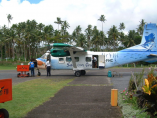
Hermann Luyken: Air Fiji plane at Matei Taveuni Fiji; 2004
Flying is the most common method of arrival in Fiji and both Nadi on the west coast and Suva on the East of the main island are well serviced. If you are staying on one of the islands you will probably end up taking a boat which is a very pleasant way to see some of the beautiful marine scenery of the islands.
Private planes are also available for those thus financially endowed. Almost all of the waves are reef breaks and will require you to have access to a boat. A few are reachable in paddling across lagoons but these are the exceptions. Local fishermen boats can be expensive, expect to pay about $60 Fijian per person for a surf – various deals can be struck for larger numbers, multiple days surfing etc but whatever you do….don’t pay the ferryman…you know the rest.
weather

Arun Kulshreshtha: Stratocumulus Perlucidus Clouds; 2006
The main influences on Fiji’s weather are the south-east
trades, the subtropical belt of high pressure over the South Pacific, and the
South Pacific Convergence Zone (SPCZ). The south-east trades are near-permanent
south-easterly surface winds that flow around the subtropical South Pacific high
toward the equator. The SPCZ is a persistent zone of low-level
convergence of the northeast and southeast trades in this area. It extends
south-eastwards from just north of Australia to French Polynesia. It shifts
north and south with the sun, which it lags by about two months. In the dry
season, it, and its associated rainfall, are farthest away. By February,
the SPCZ is at its farthest south position over northern Vanuatu. The
climate around Fiji is tropical, with wet and dry seasons, and is subject the
moderating influences of the ocean. The wet season occurs between November and
April, which also corresponds with the tropical cyclone season. While May to
October is the southeast trade wind season, with less rainfall and consistent
sunshine. Air temperatures remain mild year round thanks to the warm
South Pacific Ocean that surrounds the island and varies little from that of
the mean sea surface temperature. Air temperature around Fiji ranges from a
maximum of about 27 - 28°C in dry season to a minimum of 24 - 25°C in wet
season.
May to November.
In this season, the SPCZ and its associated rainfall are farthest away from
Fiji. As the season ends, the SPCZ approaches and rainfall increases.
Off-season tropical cycles have occurred but tend to remain mostly north of
Fiji. On very rare occasions, a cold front pushed north from the southern ocean
can bring unusually cool conditions to Fiji for a day or two. The prevailing
winds come from the southeast or east at 10 knots. Afternoon sea breeze winds
augment the offshore trades up to 25 knots but at night down slope winds and
land breeze winds dampen them somewhat early morning, perfect for your session
at Cloudbreak. Although there is much less rainfall in this season than
during the wet season, you may still see the occasional thunderstorm. Average
high temperature sit at about 27 - 28°C.
December to April
This is the rainy season for Fiji, a period when the SPCZ is closest and often
moves over the islands and contributes instability to the already humid
air. The source of air is the North Pacific high, which feeds a
tremendous amount of moisture into the convergence zone. The prevailing winds
still come from the southeast or east at about 10 knots. Thunderstorms
and heavy rain showers are frequent particularly on the windward mountain
slopes, with showers and thunderstorms occurring somewhere over the islands
almost every day. The main cyclone season extends from December-March with the
peak period in January, but cyclones have also appeared in April. Cyclones tend
to originate to the west along the SPCZ and with cyclone tracks in this part of
the world rarely following the same track. Fiji is affected by at least one
cyclone each year. Average high temperatures stay at about 24 - 25°C.
where to stay

Tim McKenna: Restaurants, Fiji (www.tim-mckenna.com)
There is excellent accommodation on the mainland all the way from Nadi through Sigatoka to the south and Suva to the East. Suva has limited surf options. Sigatoka on the Coral Coast can offer waves you can paddle to from the beach though the water quality inshore is a little brown – sometimes the wife and kids get funny about that stuff.
Nadi has good hotels and boats to run you out to Wilkes Passage – same brown water inshore though. The islands in the Mamanuca’s are expensive and some cater only for honeymoon couples – no children allowed. Then there’s Namotu – you will need to book at least 12 months in advance if you want to visit during the main swell season and then you will only be on a reserve list. The island only accommodates 40 guests at a time and the American owners tend to allow some of their customers to book the island for years in advance.
For what it’s worth, Fiji has passed a law prohibiting the future sale of islands but based upon what has been discovered to date in Fiji – it's all too late, Namotu and Tavaru have it all sewn up.
what to pack
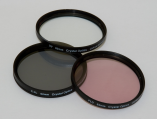
Rich Niewiroski Jr.: 62 mm ultra-violet, fluorescent, and polarizing lens filters. Camera used was a Canon 400D; April 9, 2007
Take a very good sunscreen with high level of protection. It is
absolutely essential, as well as sunnies, hats, long sleeved shirts and
long skirts for ladies to cover legs. Don’t underestimate the strength
of the sun; your skin won’t forgive you. Just in case you still ignore
our advice, take a lot of Aloe Vera. Repellent might be useful as well.
Medicines – as usual.
You may also need a pair of waterproof boots and a good backpack if you
plan to explore the islands. Depending on the season tropical rains can
be quite often, so it’s a good idea to take something waterproof if you
plan to go outside. Another option would be just to stay at you place
and have a nap – the whole atmosphere is very laidback.
Though many resorts have snorkelling gear, better take your own,
especially if you plan to do a bit of travelling to different islands.
Take a few light and casual things, nothing fashionable – you won’t
need it there. Camera, adaptor, good books to read and music. Oh, yeah,
booties, helmet and top will be useful on the reef break, as it can get
quite shallow.
dangers and warnings
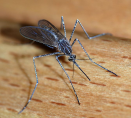
Alvesgaspar; Mosquito; 11.2007
Fiji is generally a safe place, the locals are warm and friendly and there is little in the way of disease here. The most common thing to look out for is petty theft in the major cities on the main island of Viti Levu, places like Nadi and Suva. Other than that you'll be fine. Be aware that homosexual practice is illegal here and if caught you do risk imprisonment, though they state homosexuals are welcome.
Avoid mosquito-borne illnesses, such as dengue fever and even elephantitis by covering up thoroughly or using repellents while outdoors at dawn or duskrestaurants, shopping and nightlife

Lovecz; A 50gram packet of Kava powder; 25.05.2008
Most Fijians eat out in one of the many cafes and beach bars that line the streets and water front and serve up some delicious and wholesome meals. A lot of Fijian dishes have a strong Indian and partly Chinese influence, the Fijian curries are great value and very tasty. Fresh fish and chips (thick cut fries) are also widely available as is seafood of all kinds and fresh fruit. A simple dish you may be served on some of the more remote islands is fresh chicken, either curried or served with pieces of fried bread fruit.
A popular drink in Fiji is kava, it has a slightly peppery but more muddy taste and looks like dishwater! It's made from the root of a native pepper plant piper methysticum, and has a mild narcotic effect. You may feel a little numb for a few minutes after consumption. It's usually served in a halve coconut shell and you have to clap your hands once before drinking.
As for nightlife, Fiji is pretty quiet, especially on the outer islands, you'll find beach bars staying open until late serving Fiji Bitter and all manner of cocktails and one or two of the islands have earned the reputation of "party islands" that are popular with backpackers. Some of the larger resorts have their own nightclubs too.
what to do when it's flat
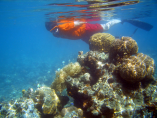
Masato Ikeda; Reef Snorkeller; 16.07.2003
In Fiji there are still loads to do when the surf runs out of grunt; you're in Fiji its great! The water here is some of the most beautiful you'll see anywhere in the world and the snorkelling is awesome, but why not take it a step further and enrol on a scuba course, if you're not already qualified and if you are need I say more?
If you don't fancy the scuba plan than island hoping is a great way to pass a few days, it's easy to arrange lifts on fishing boats and accommodation at people houses on the more remote outer islands and you'll get a true feel of real Fijian life. Some of the islands are tiny and all have their own character and mini eco-system. Some are low lying and sunny with beautiful beaches and others are more rugged and mountainous producing a more rain forest feel. All are worth a visit.
How about a spot of reef fishing, arranging that is simple or beach soccer there's always games going on around and the locals are happy for you to join in.
A couple of the islands are popular with backpackers and are now "party island" status so a trip there to meet some interesting characters over way too many Fiji Bitters is also a great swell gap filler and guaranteed to turn the surf on when you're hung-over!!
useful phrase guide

Indolences; Standard Question mark; 04.05.2007
The official language of Fiji is English and it is widely spoken across most places you will visit. However, the is a local Fijian language known as Hindustani which is also spoken a little, mostly by older locals and learning a few basic words will earn friendship and respect, most Fijians will greet you with a smile and "Bula" meaning hello in an informal way, here are a few more:-
Hello Bula
Good bye Moce
Please Kerekere (kerry-kerry)
Thank you Vinaka
Thankyou very much Vinaka vaka levu
Yes Io (Ee-yo)
No Sega (senga)
No worries Sega na Lega (Senga-na-lenga)






